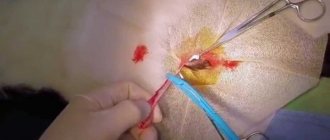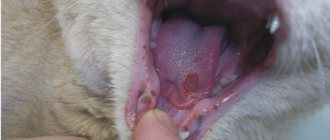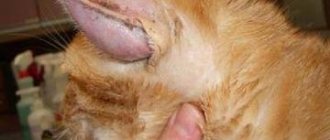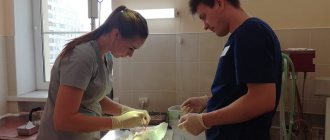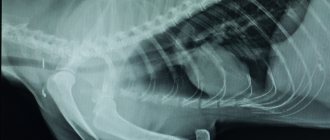6830Pavel
Fluid in a cat's lungs is a dangerous condition that requires immediate treatment. Fluid in the lungs appears because the capillaries are overflowing with blood, and fluid begins to be released through the walls, which accumulates in the alveoli. As a result, the cat develops pulmonary edema. With such a violation, the pet cannot breathe fully, and oxygen starvation occurs. If urgent measures are not taken, the death of the animal is likely.
Complication after sterilization
This procedure is now used on most of the adult cat population. Most often, cats tolerate it calmly and recover from anesthesia normally. But in some cases, pulmonary edema may develop in cats after sterilization. The animal sticks out its tongue and becomes immobilized, its mouth turns blue. This condition is a consequence of the fact that before the operation the doctors did not examine the heart and did not identify any abnormalities in its functioning, which now lead to similar complications. In this case, oxygen therapy should be applied to the cat, as well as Furosemide and Prednisolone should be administered intramuscularly or intravenously. Usually the condition improves somewhat after injections, but continued treatment is required.
Main predisposing factors
Very often this happens in cases where the cat being operated on has cardiomyopathy.
. With this pathology, the heart can either turn into a kind of flabby sac (dilated variety), or shrink due to the proliferation of connective tissue. There are also transitional and mixed varieties.
Regardless of the type of illness, it always leads to the same thing - the organ ceases to perform its function normally, and congestion develops in the pulmonary circulation. In this case, any operations, including castration, are strictly contraindicated. In addition, the sick cat will have to undergo treatment for the rest of its life to ensure its quality of life remains at an acceptable level.
This also includes all types of allergies.
. If your pet is predisposed to their development, we strongly advise you not to castrate your cat “at random”. Take him to a veterinarian in a good clinic ahead of time, let the specialist test various types of sedatives and select the one that will minimize the likelihood of developing an allergic reaction. Otherwise, it may well happen that the pet will die, suffocating, right on the operating table.
Finally, you should never discount individual drug intolerance
. Thus, in the recent past, xylazine was very often used during anesthesia (and even now it is often used). This medicine very often provokes the development of pulmonary edema in cats, and many cases of the “delayed” version of the pathology are known. However, it is extremely difficult to prove the relationship between xylazine and the swelling that occurred a week after surgery. But experts and experienced breeders are confident that a relationship exists.
Symptoms
The presence of fluid in a cat's lungs can be suspected by certain manifestations. The main symptoms of this pathological condition are
:
- decreased reactions to external stimuli;
- pallor of mucous membranes;
- heavy, complicated breathing, in which gurgling sounds are clearly audible;
- intense cough with pink sputum;
- sticking out tongue when coughing;
- increased pulse, which gradually becomes weak;
- coldness of paws;
- unsteadiness of gait.
As soon as symptoms of fluid in a cat's lungs are noticed, it should be taken to a veterinarian immediately.
Treatment
The treatment regimen will depend entirely on the diagnosis. If a disease is detected that causes fluid accumulation in the tissues, treatment is directed specifically at its elimination.
But whatever the disease, therapy is primarily aimed at eliminating severe symptoms and reducing fluid in the cat’s lungs.
Providing first aid for pulmonary edema
To relieve pulmonary edema, the “patient” is given an intramuscular injection (Dexamethasone, Hydrocortisone, Prednisolone, Diprospan). Each of these drugs has an effective anti-edematous effect and helps to avoid acute hypoxia.
To compensate for the lack of oxygen in the cat’s body, the doctor can put it in a pressure chamber or put an oxygen mask on its face.
Also, the “fluffy” is administered (orally or by injection) a diuretic drug to remove excess fluid.
In severe cases, when the animal is near death, artificial ventilation or intubation is performed.
Just like people, when they are sick in an unfamiliar environment, cats experience a lot of stress. To calm the “mustachioed” one, he is given sedatives.
Further therapy
While the cat is in an unstable condition, she is left in the clinic for inpatient treatment. Further therapy will depend on what caused the pulmonary edema. If the problem occurs as a result of injury, poisoning or other external factors, then, as a rule, after the symptoms are relieved, the cat is no longer in danger and can go home to recover.
If heart disease or other diseases are detected, their treatment begins. Some heart pathologies are incurable and relapses with edema can occur unexpectedly in a cat. In such cases, the cat needs constant supervision and regular examination (every six months or year) to avoid crises.
Antibiotic therapy is used to eliminate bacterial infectious diseases. If the lung disease was caused by viruses, then appropriate antiviral drugs are used.
There are a lot of diseases that can cause pulmonary edema. Therefore, it is difficult to say what other treatment can be prescribed for a cat.
Regardless of the disease, after a crisis the animal needs rest and good nutrition to recuperate. Along with medications, it is recommended to add vitamins. The room where a sick cat lives should be well ventilated.
Forecasts
Pulmonary edema in a cat is considered a very serious disease. Veterinarians have special methods of treatment and assistance, but owners should be aware that in some cases this disease is a dying condition. If the animal is young, with a strong immune system, then recovery is possible. However, in this case, the risk of relapse remains. If repeated swelling is observed within several months, this leads to death in almost 100% of cases.
conclusions
From all of the above, we can conclude: pulmonary edema is a serious illness with an unfavorable prognosis at the slightest delay, but it can be treated if pets are treated with due attention and care. A timely visit to the doctor is the key to a long life for your pet.
Pulmonary edema is an acute condition in which the amount of fluid in the lung space exceeds the normal level, which leads to impaired gas exchange.
When this pathology appears, owners often think: “Is it possible to cure pulmonary edema in a cat, and is this condition fatal or not?” Treatment for pulmonary edema depends on the severity and cause. If there is minimal suspicion of pulmonary edema, you should immediately take the animal to a veterinary clinic, since it is almost impossible to stabilize the condition at home. The prognosis of this disease is cautious, often unfavorable, due to late access to a veterinary clinic and treatment.
The causes of pulmonary edema can be different, depending on the type. They are generally divided into cardiogenic and non-cardiogenic.
Cardiogenic pulmonary edema is a pathological process that is caused by disturbances in the functioning of the heart. When intracapillary pressure increases, the leakage of fluid into the alveoli from the capillaries is disrupted, and blood accumulates and stagnates in the vessels of the lungs.
Non-cardiogenic pulmonary edema is caused by non-cardiac problems and often occurs with increased permeability of the walls of the pulmonary vessels. The causes of this disease can be chest injuries, sepsis, and the release of various liquids and toxic gases into the respiratory tract.
Usually, owners notice symptoms of pulmonary edema such as lethargy, lack of appetite, posture with the front paws apart, shortness of breath, breathing with an open mouth (like dogs breathe), blue-violet mucous membranes, abdominal type of breathing, sometimes even wheezing and gurgling can be heard sounds. Cough occurs less frequently.
Is pulmonary edema treated and how to relieve it? Treatment methods: first of all, you need to take the animal to a veterinary clinic, try to expose it to less stress at the moment. When collecting an anamnesis, the doctor should immediately place the cat in an oxygen chamber or allow it to breathe oxygen using a mask; in extreme cases, resuscitation and connection to a ventilator are used to saturate the body cells with oxygen. Diuretics (diuretics) are used. First, acute symptoms are relieved, then they try to eliminate and find the causes, if possible. To do this, auscultation is performed (listening to the lung area using additional instruments), an x-ray, and a general blood test is taken in order to diagnose the underlying disease. More often than not, your pet diagnosed with pulmonary edema is placed in a hospital, since constant monitoring of the animal and the use of various therapeutic and diagnostic measures are required.
Causes
Often pulmonary edema is of cardiac origin. When a cat has a disturbance in the pulmonary circulation, blood stagnation develops in the lungs and the alveoli fill with fluid. Cardiac pathologies that can lead to swelling of the lung tissue include
:
- heart disease;
- thromboembolism of the pulmonary artery;
- aortic heart disease;
- cardiomyopathy.
In all these cases, the fluid first appears in the lower sections and gradually rises up to the bronchi.
Fluid accumulation in the lungs not due to heart problems can occur due to the following:
:
- the cat inhaling very hot air;
- long-term exposure to chemical gases on the animal’s respiratory system;
- lobar pneumonia;
- sunstroke;
- heatstroke;
- feline distemper;
- electrical injuries;
- traumatic brain injuries;
- sepsis;
- serious drug overdoses;
- renal failure;
- acute allergic reactions;
- cancerous tumors;
- asthma.
If there are factors predisposing to the onset of the disease, monitoring the cat’s condition should be especially careful. If there is the slightest suspicion of the onset of the development of a pathological condition, the animal must be immediately shown to a veterinarian.
How to help your pet?
This disease poses a serious threat to the life of the tailed creature, so therapy is immediate and first of all, a high dose of diuretics (furosemide, Lasix) will be required, which will reduce the level of fluid inside the tissues.
To reduce the inflammatory process and against an allergic reaction, dexamethasone is considered effective. At the same time, the sick mustache will receive an intravenous injection with solutions of glucose or sodium chloride. If hypostatic pneumonia is suspected, antibiotic therapy is prescribed.
To stimulate the breathing process, the pet will be placed in a special chamber and an oxygen mask will be placed on its face.
Whatever the cause of the disease and its severity, it is better to leave your tailed friend in a hospital, where his condition will be monitored around the clock.
How does the disease manifest itself?
How can you detect pulmonary edema in cats? The symptoms can be quite different, however, we will list them all so that the owners know what to look for.
First of all, your pet should be alert to rapid breathing and shortness of breath. Even a slight manifestation of these signs is a sufficient reason to contact a veterinarian.
We have already looked at how pulmonary edema develops in cats. The reasons in each case may be different, which means the intensity of the development of symptoms will also differ. The owner should be wary of abdominal breathing, since this is an atypical method for representatives of this species, and it indicates obvious problems.
In later stages, your pet will suffer more and more. His mucous membranes turn blue, the cat breathes with an open mouth and clearly visible wheezing. Even later, a cough with sputum and blood appears, the limbs become cold - it is almost impossible to save the animal at this stage.
Clinical picture of the pathology
It is quite simple and characteristic, the symptoms are pronounced and clearly visible even to an inexperienced breeder. The animal suddenly begins to choke, its breathing becomes intermittent and hoarse. All visible mucous membranes turn blue, the body temperature may rise slightly at first, but then always drops so that even the cat’s skin becomes noticeably cooler than normal. The pet is choking, coughing heavily, and flaky pieces of foam periodically fly out of its nasal openings and mouth.
Note that pulmonary edema in a cat does not always develop immediately after castration.
Many cases have been described where animals “fell over” a week after surgery! By the way, in such cases it can be extremely difficult to connect sterilization and swelling. It is quite possible that more than 70% of “delayed” cases actually have nothing to do with castration and are caused, for example, by poisoning. Since cases are rare, no one has simply conducted detailed studies. What causes can be identified for “true”, postoperative pulmonary edema?
Pulmonary edema in cats: symptoms
The following signs are noted:
- the pet breathes heavily with an open mouth;
- the paws are spaced wide apart, the head is tilted, in some cases the cat lies on its side and makes fruitless attempts to rise;
- the eyes are indifferent, the pupils are dilated, the animal is scared;
- the pet does not respond to the owner’s call or the surrounding environment;
- the mucous membranes first acquire a pale tint, then become bluish;
- the cat coughs excessively, the alveoli are injured, pink-colored sputum comes out;
- Foamy discharge begins to fall out of the nose and mouth;
- the tongue falls out of the mouth;
- The heartbeat is initially rapid, but subsequently becomes intermittent and weakens.
The heart tries to provide oxygen to the vessels of the brain; it does not have enough strength to reach the periphery. Therefore, the paws become icy.
There are the following cat breeds that are prone to heart failure, and therefore edema:
- Maine Coons;
- British;
- Sphinxes;
- Scots;
- Persians.
Kittens do not have cardiogenic pulmonary edema. They suffer due to chest injuries.
Symptoms of pulmonary edema
Older animals with heart disease are most susceptible to the disease.
The main signs of the disease are manifested in the cat’s behavior. The pet spreads its legs wide and tilts its head, trying to inhale air. When touched, cold paws are felt. The animal may lie on its side for a long time, no longer able to rise.
Fear comes first in the gaze, the eyes become empty, and the cat’s panic is felt.
- The pet does not respond to the environment or the owner’s call.
- Pallor of the oral mucous membranes followed by cyanosis is visible.
- Breathing is difficult, accompanied by the release of pinkish sputum. When coughing,
bubbling or gurgling sounds are heard. Foamy nasal and oral discharge may occur, with the tongue protruding. - Rapid heartbeat followed by intermittent and weak heartbeat.
With pulmonary edema, the cat will look panicked.
Ends with paralysis of the respiratory nerves and death of the animal
. The disease is very acute and has a lightning-fast course, but according to some signs it can be noticed in time and treatment can be started immediately. The onset of the disease is manifested by shortness of breath. The cat breathes more often with its stomach or open mouth. Breathing is very rapid and uneven, with periodic short coughing.
Having noticed such signs, the owner should immediately contact the clinic, otherwise delay threatens the inevitable death of the pet.
Non-cardiogenic form
In this case, the doctor needs to understand the reasons that led to such a violation. This may be a consequence of electrical trauma and brain damage. If such an event occurred, then you must definitely go to the clinic. Such swelling may not develop immediately - this is the main danger.
An infectious pathology can also lead to a similar result. In this case, inflammatory edema develops. The cause of this complication may be a disruption of the gastrointestinal tract. Another broad category is toxic swelling, which is caused by carbon monoxide poisoning or snake venom.
Allergic conditions and anaphylactic shock, septic shock, tumors blocking the lymphatic vessels - all these are also options for events in the presence of which pulmonary edema develops.
First aid
If you observe one or more of the symptoms described in your pet, then remember that the sooner you take him to the hospital, the better the doctor’s chance of treating pulmonary edema in cats. Treatment is symptomatic, and depending on the severity of the symptoms, the specialist may change the treatment regimen. The animal must be placed in a ventilated room and drafts should be avoided.
Before you arrive at the hospital, do not try to give the animal water or force it to rest. In addition, it is very dangerous to independently give an animal drugs to stimulate breathing, try to pump out fluid, or perform artificial respiration. Many owners ask doctors whether pulmonary edema in cats is fatal or not? In some cases, this disease can be fatal, however, competent therapy can save if this complication is at an early stage. Edema requires intensive care and constant medical supervision, so in this case, hospital treatment is the best option.
What are the dangers of self-medication of pulmonary edema?
Some people are interested in whether it is possible to cure pulmonary edema in a cat on your own? Under no circumstances should you do this. Firstly, special medications and injections are required to quickly relieve swelling and replenish oxygen in the animal’s body. Secondly, as mentioned above, edema is not an independent disease, but only a consequence of another pathology. And it’s not enough just to eliminate the swelling, you need to find the cause and try to cure it.
At home, a cat can be given first aid, but it is still necessary to take it to a specialist for examination. Even if you manage to remove fluid from the cat’s respiratory system on your own and relieve pulmonary edema, a relapse risks reoccurring with even more serious consequences.
What is pulmonary edema in cats
Edema occurs due to excess fluid accumulation in the tissues. This is not an independent pathology, but a symptom of the underlying disease.
If fluid is allowed to fill the entire lung tissue, the cat will die from respiratory arrest. When half of the lungs do not function, oxygen starvation of the organs develops, primarily the brain.
Diagnostics
If the doctor makes a diagnosis only on the basis of an initial examination, take your pet and go in search of a more competent specialist. An accurate diagnosis cannot be made without a comprehensive examination. The veterinarian must prescribe an ultrasound, do an x-ray and take tests. Only based on the results can a specialist make a final diagnosis. However, you will not be sent home to wait for the tests to be ready: ultrasound and x-rays can be done almost instantly in most clinics. After this, if suspicions of edema are confirmed, leave the pet in the hospital. The test results will only tell the doctor what direction to work in, or rather, what the root cause of the swelling lies.
Diagnosis and treatment
There are several diseases that have a similar manifestation with pulmonary edema in cats, and which must be excluded, among them: dirofilariasis, pneumonia, bronchitis, etc. To do this, it is necessary to conduct a clinical and biochemical blood test, you can also include determination of the level of natriuretic peptide, which will indicate the relationship between existing pulmonary edema and heart disease.
Next, it is necessary to conduct an X-ray examination of the chest cavity, which will reveal fluid retention in the lung tissue and the possible presence of free fluid in the chest cavity. If cardiogenic pulmonary edema is suspected in cats, an echocardiographic examination of the heart should be performed to exclude cardiomyopathies and the presence of pericadial effusion.
Pulmonary edema in a cat
In a veterinary clinic, the doctor will first of all pay attention to the clinical manifestations of the disease. The owner should tell the specialist about changes in the behavior of the mustache and describe the symptoms in detail.
Often, at the first suspicion of pulmonary edema, a veterinarian immediately prescribes treatment and conducts other tests during therapy, because with this problem with the respiratory system, every minute is important - the mortality rate among cats with pulmonary edema is very high.
It is not difficult for a veterinarian to identify pulmonary edema in a cat. The doctor listens to breathing, detects wheezing and gurgling in the bronchi. An X-ray of the chest reveals the affected area with swelling, which becomes darkened.
To determine the cardiogenic factor, the animal undergoes an ultrasound of the heart, which shows an increase in muscle volume and obstructed blood movement in large vessels. An ECG detects an abnormal heart rhythm.
The final diagnosis is made after the results of a biochemical blood test. It shows an increase in white blood cell levels, as well as AST and LST.
Often the examination is combined with treatment of pulmonary edema in a cat, as symptoms develop rapidly.
Diagnosis of pulmonary edema involves a whole range of studies. The specialist prescribes tests, x-rays and ultrasound. Most clinics provide X-ray and ultrasound results immediately. Tests will tell your veterinarian what is causing the pulmonary edema.
Auscultation of the lungs
First of all, resuscitation measures are taken to relieve swelling. For this purpose it is advisable to use:
- diuretics (diuretics), which help remove excess fluid,
- foam suppressants,
- vasodilators,
- glycosides to maintain heart function: camphor, caffeine, cordiamine, adrenaline, etc.,
- bloodletting.
Then follow the generally accepted procedure:
- eliminating the cause of the disease,
- the pet is given complete rest,
- sit comfortably in a cool and well-ventilated room (but not in a draft);
- expectorants are prescribed;
- drips with calcium chloride and glucose are placed;
- antibacterial agents are used according to indications,
It is also necessary to resort to oxygen therapy: the animal is placed in a special oxygen cage; in especially severe cases, artificial ventilation may be necessary.
Basic treatment
As we have already said, it will be symptomatic, that is, the doctor must, based on the condition of the animal, decide which drug is the priority today. It is very important to give expectorants and cordials. There is a wide choice here, and depending on the situation, the veterinarian can prescribe Cordiamin, Sulfocamphocaine, adrenaline or caffeine. Sometimes it is useful to do bloodletting. A glucose solution (40%) or a calcium chloride solution (10%) is used intravenously. In addition, it is very important to evaluate clinical tests:
- If a cat has symptoms of plague, then additional antiviral drugs are prescribed.
- If a cat has symptoms of hypostatic pneumonia, antibiotics are additionally used.
- Diuretics are essential for optimal treatment. Lasix or Furosemide are often prescribed.
Remember that the decision about the necessary treatment should be made only by the doctor. In the case of self-therapy, the possibility of death increases several times. However, feline pulmonary edema can be treated. The most important thing is not to waste time and be sure to contact the clinic at the first symptoms.
First aid before going to the veterinary clinic
If there are signs of pulmonary edema, first aid must be provided to the animal:
- ensure patency of the upper respiratory tract;
- establish inhalation of oxygen from an oxygen cushion;
- If possible, give a diuretic such as furosemide;
- It is better to transport a cat to the hospital in a position lying on its side, but do not put it down forcibly (if it wants to sit, let it sit);
- The animal should be provided with complete rest, limiting physical activity.
Pulmonary edema in cats: treatment
Treatment begins before a final diagnosis is made. Resuscitation procedures are carried out. The cat is hospitalized and put on an oxygen mask or placed in an oxygen chamber.
To remove excess fluid from the lungs, diuretics are injected. They use drugs that support heart function, stimulate breathing, and stop the inflammatory process.
If it is determined that pulmonary edema is due to a bacterial infection, antibiotics are prescribed. After the acute symptoms are relieved, the diagnosis is clarified. To do this, a general as well as a biochemical blood test and instrumental studies are performed - x-rays, ultrasound, ECG. After deciphering the results, treatment is prescribed.
Diagnostics in a veterinary clinic
Many veterinarians use chest x-rays to confirm the diagnosis of pulmonary edema. Once diagnosed, your doctor may recommend additional testing to determine the nature of the fluid and explore possible causes of the condition.
The doctor may insist on additional examination
Note! If the animal’s condition is serious, even before a detailed examination, treatment is prescribed aimed at stabilizing the condition.
Methods of laboratory and instrumental examination
- general blood analysis;
- electrocardiography, ultrasound examination of the heart;
- culture of sputum, urine;
- arterial blood gases;
- X-ray of the chest organs.
Prevention
There is no specific prevention, because pulmonary edema itself does not develop in cats. This is a complication, that is, a consequence that is preceded by one of the diseases listed above. It is impossible to foresee everything, especially since our younger brothers cannot explain that they felt bad and where it hurts. However, prevention can be expressed in regular visits to the doctor. Preventive examinations and monitoring of the body’s condition will not allow a situation where you learn about your pet’s heart failure only when pulmonary edema develops.
Disease prevention
Pulmonary edema is a very serious disease, which in most cases ends in the death of the animal, so it is very important to follow the rules of necessary prevention.
Exercise constant strict control over pets at risk: animals that are obese or lead a sedentary lifestyle. It is important to keep an eye out for pets with heart disease or a genetic predisposition to heart disease.
If you have a British child, then know that he is at risk.
- Carefully monitor Maine Coon, British, Scottish, Persian, Abyssinian, and Sphynx cats, due to the fact that these breeds are very sensitive to diseases of the cardiovascular system. Pay special attention to lazy pets who love to sleep and lie on the sofa.
- Among other things, it is necessary to feed with high-quality food , not to be tempted by low prices, but to choose brands from well-known companies.
- Prevent the risk of hypothermia , avoid long walks in winter to avoid the development of colds and complications associated with them.
- Limit access to electrical appliances, control exercise in the summer heat. Do not allow animals to inhale toxic fumes or hot air.
- Vaccinate your cat on time and undergo a timely examination at the clinic.
Pay attention to lazy cats!
Knowing about the heart problems of your pet, you should carefully monitor all changes in its behavior and immediately contact a veterinarian at the slightest alarming signs.
Causes of the condition in cats
But for what reasons does pulmonary edema develop in cats? Is there any way to protect your four-legged friend? How to correctly recognize it and help a purr with such a severe pathology? There are many causes of pulmonary edema in cats. Let's look at all the possible options.
Dehydration
No matter how strange it may sound, pulmonary edema in a cat can develop both due to starvation and due to poisoning. In this case, a huge amount of water leaves through the gastrointestinal tract, and the pet becomes dehydrated.
As a result, the oncotic pressure decreases, and the liquid fraction begins to sweat out of the blood. It is this that accumulates in the lungs, causing swelling. In addition, problems with the kidneys and liver lead to a decrease in oncotic pressure.
Increased permeability of blood vessels (distress syndrome) can aggravate the condition. It develops due to poisoning with serious poisons, medications, smoke and toxic fumes, and due to previous injuries (including pulmonary injuries). Many diseases of internal organs (even pancreatitis) can lead to the vessel wall becoming less durable and capable of allowing fluid to pass through its surface into the intercellular space.
Heart failure can also cause pulmonary edema in a cat. The pet may have problems with the heart itself, or the purr is constantly tired (the heart is almost worn out). Therefore, if you already know about this illness in your pet, keep in mind that he is at risk. And for you, this is another reason to monitor him more carefully.
Other reasons
Tumors and other neoplasms can also be causes, but relatively less often than those mentioned above.
In determining the causes of pulmonary edema, there are provoking factors and direct mechanisms for the occurrence of the disease.
According to the mechanisms of occurrence there are:
- Cardiogenic. Occurs against the background of acute or chronic heart failure. The most common causes are heart defects, arterial hypertension and cardiosclerosis.
- Non-cardiogenic – quite rare in cats. Usually associated with blockage of the upper respiratory tract - swelling or paralysis of the larynx, abscesses, foreign bodies, as well as anaphylactic shock and gas poisoning.
Provoking factors include various chest injuries, concussions and electrical injuries. This also includes the entry of vomit into the respiratory tract.
Another reason for the development of the disease can be inflammatory infectious processes.
Which develop directly in the tissues of the lungs - pneumonia, tuberculosis, carnivore plague.
Neoplasms are also one of the reasons for the development of edema. As well as diseases of other organs and systems - kidneys, liver and poisons.
We suggest you read: Is it possible to sterilize a pregnant cat?
Pulmonary edema in cats occurs due to the overflow of pulmonary capillaries with blood, accompanied by the release of the liquid part into the surrounding tissues. By its nature, the disease can be cardiogenic, that is, arising against the background of heart disease, and non-cardiogenic.
Heart reasons
Cardiogenic edema, as already noted, is the result of heart failure. As a rule, with weak functioning of the left ventricle (one of the parts of the heart), the work of the pulmonary circulation is disrupted, which leads to stagnation of blood in the lungs and subsequent leakage of fluid into the surrounding tissues.
This state can be compared to a porous sponge: up to a certain point, it swells and absorbs water without leaving a trace, but there comes a moment when there is no space left and the water flows out.
For cardiogenic causes, edema begins in the lower sections, but gradually the process moves to the bronchi.
It is worth noting that the prognosis for pulmonary edema is unfavorable, especially if it is caused by a heart defect.
Other factors
Non-cardiogenic causes of hyperemia (another name for the disease) are the following:
- inhalation of hot air;
- inhalation of potent gases with a pungent odor (for example, prolonged exposure to high concentrations of ammonia vapor will easily cause swelling);
- lobar pneumonia;
- heat or sunstroke;
- bacterial or viral infections that affect the lungs (pasteurellosis, canine distemper, etc.);
- exposure to electric current;
- brain injuries due to an unsuccessful fall or blows;
- development of the septic process;
- taking certain potent medications in dosages significantly higher than recommended;
- renal failure, when the protein concentration in the blood sharply decreases;
- allergy;
- bronchial asthma;
- malignant tumors in the lungs that interfere with normal blood supply.
It is important to understand that pulmonary edema is a serious and very severe pathology, often ending in the death of a cat.
Pulmonary edema in a cat is accompanied by coughing and difficulty breathing.
An animal suffering from heart defects, especially if it is already of advanced age, is at risk. Therefore, any self-respecting owner of a sick pet should learn to recognize the signs of impending danger. And they are:
- the cat suddenly takes a forced pose: stands with its forelimbs widely spaced and its head bowed, thereby trying to inhale as much air as possible, its sides are greatly inflated;
- paws become cold;
- after a while the animal falls exhausted on its side and never gets up again;
- the mucous membranes of the mouth turn pale or become cyanotic;
- the animal has difficulty breathing, coughs heavily, and produces pinkish sputum;
- seething, bubbling cough;
- foamy discharge may occur from the nose and mouth;
- tongue hangs out;
- the work of the heart weakens, the pulse first quickens, and then becomes weak and intermittent;
- death occurs as a result of paralysis of the respiratory center.
The behavior of the animal also changes:
- firstly, he is scared, and fear can be read in everything;
- secondly, the lack of oxygen confuses the consciousness, the gaze becomes crazy, and then empty and unseeing;
- thirdly, the cat stops reacting to its surroundings and does not recognize its owners at all.
Despite the fact that edema is an acute and rapidly developing condition, you can notice the approaching danger in advance if you carefully observe your pet and its behavior. Typically, within a few days the breathing rhythm may become disrupted:
- the animal breathes with its stomach (the abdominal stacks shake) or through the mouth;
- the number of rhythmic inhalations and exhalations per minute increases significantly (more than 40);
- the breathing itself is wheezing and labored with periodic hacking coughing.
It is clear that such symptoms do not always indicate developing edema, but the time to ring the bells has already come. It is better to play it safe and take the animal for diagnostics to a clinic, where they will order an x-ray and perform auscultation (in other words, they will listen to the lungs using a special device) and check the functioning of the heart.
Moreover, it is better to film a cough and an altered state on video - fortunately, now almost everyone has a phone with a camera. This will help the veterinarian see the progression of the disease over time, decide on the prescription of additional diagnostic tests and speed up the diagnosis.
Important! It is much easier to cure a process that is caught in a timely manner than to try to correct a neglected and altered condition, which is most often no longer compatible with life.
There is no need to console yourself with excessive hopes: in most cases, pathology is regarded as a dying condition! There is a chance to rescue an animal from the dead only if non-cardiogenic edema occurs.
Even if it was possible to stop the development of the process in the case of cardiac causes, the likelihood of a recurrence of the attack is too high.
If your cat has pulmonary edema, your cat needs immediate medical attention.
The disease requires immediate intervention from specialists; attempts to help the pet on your own will significantly aggravate the condition and hasten the approach of death.
All that the owner can do (provided that the swelling occurs due to heart failure) is to inject a solution of furosemide intramuscularly - a diuretic drug helps remove fluid from the body - and urgently go to the veterinary clinic.
Important! Using diuretics unless prescribed by your veterinarian is still not recommended.
In case of hyperemia, resuscitation cannot be avoided; further observation in a hospital is required. It is not possible to cure an animal with a telephone consultation!
When going to the hospital, it is important to try not to irritate the animal, especially at the time of the attack, so that the situation does not become even more complicated. There is no need to fuss, run, sob, cry - the cat feels all this and, naturally, gets stressed. And stress, as we know, does not lead to good things.
The resuscitation scheme usually includes the use of an oxygen cushion (chamber), in some cases tracheotomy and the administration of:
- diuretics (diuretics) to remove accumulated water in the lungs;
- defoamers;
- vasodilators;
- cardiac drugs to stabilize the heart;
- bloodletting;
- novocaine blockade of sympathetic nodes.
After the crisis has passed, the animal is placed in a cool, well-ventilated room (but ventilation does not mean a draft) and symptomatic treatment is applied: expectorants, antibiotics, etc. It is very important to determine the cause of the edema and eliminate it.
Most cases of pulmonary hyperemia end in the development of complications, which also need to be, if not prevented, then at least correctly diagnosed and treated. The most common consequences include:
- pneumonia;
- collapse of the alveoli (atelectasis);
- overgrowth of the alveoli with connective tissue (pneumosclerosis);
- emphysema - overfilling of the alveoli with air followed by their rupture.
In addition, prolonged oxygen starvation negatively affects almost all organs, especially the cells of the brain and kidneys.
For cats with heart problems, constant monitoring of the state of the cardiovascular system and heart function is necessary. It is especially important to constantly monitor animals at risk:
- obese people;
- with confirmed caryomyopathy;
- leading a “sofa” lifestyle;
- having relatives with heart problems;
- British, Scots, Macoons, Persians, Abyssinians and Sphynxes - those breeds that most often suffer from heart disease;
- drowsy and easily overtired.
Disease Prevention
In order to exclude the occurrence of the disease as much as possible, you should regularly take your mustache to the veterinary clinic for examinations by specialists. This is especially important for cat breeds that are at risk and purrs that are already living with cardiovascular problems.
Fluffies with signs of obesity, leading a passive lifestyle, as well as cats who have relatives with heart problems are at some risk.
It is very important to check the heart condition of your four-legged friend before sterilization. In some cases, fluffies do not tolerate anesthesia and the procedure itself, which causes swelling of the respiratory system (if the cat initially had heart problems).
Diagnostics and timely therapy are incredibly important - it can save the life of your beloved creature.
Symptoms of pulmonary edema in a cat increase very quickly, and can also be expressed gradually and in attacks.
Dyspnea.
When swelling occurs, the first thing that occurs is heavy breathing. There are also changes in the type of breathing in cats: the traditional one is thoraco-abdominal, and when edema occurs, the four-legged pet begins to breathe only with the stomach.
Wheezing when breathing.
If a cat begins to wheeze noticeably while breathing, this indicates an incipient illness and the appearance of inflammatory processes in the oropharynx and trachea. Gurgling and bubbling with wheezing, accompanied by nasal discharge, clearly indicates pathology in the lungs.
Breathing with an open mouth.
This behavior is not typical for representatives of the cat family. Sometimes cats may breathe with their mouths open after vigorous play or hyperactivity. But it doesn't last longer than a couple of minutes. If a cat sticks out its tongue, breathes heavily and frequently, or suffocates, then this is a cause for concern.
The mucous membranes and tongue turned blue.
This is a sign of respiratory failure, as well as oxygen deficiency in the lungs and tissues. At first, the mucous membranes and tongue may become very red, and then turn blue.
Cough.
It indicates the body's attempts to remove mucus and fluid from the alveoli. This process is reflexive in nature. The cough with edema is always wet, with expectoration of sputum, mucus and sometimes blood.
Decreased activity.
Due to breathing problems and lack of oxygen, the furry ward becomes lethargic and apathetic, and weakly reacts to external stimuli. To increase the volume of the chest, the animal can take a pose with its front legs widely spaced.
Preventative measures include regular examination by a veterinarian. This is especially important for those felines who have previously been diagnosed with cardiac problems. The doctor will determine the exact degree of heart failure and stop the development of pulmonary edema.
Also, periodic examinations are necessary for pets belonging to the risk group. Veterinarians recommend doing a cardiac ultrasound or screening echocardiography. Such studies are aimed at identifying diseases that are not accompanied by clinical signs.
Treatment and diagnosis of pulmonary edema in cats, carried out in a timely manner, will help save the lives of animals.
Video on the topic
Pulmonary edema in cats is a disease that can lead to the death of a pet. The structure of a cat's lungs is largely the same as a human's. They are alveoli that are filled with air and entangled in a network of blood vessels. Under the influence of various factors, a large amount of blood collects in the pulmonary capillaries, which contributes to a decrease in lung volume and oxygen starvation. Fluid accumulates in the alveoli and the cells become unable to breathe.
